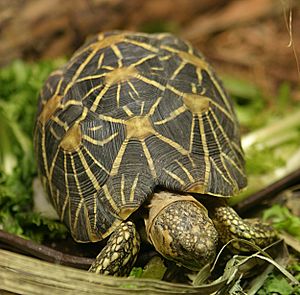Geochelone
| Geochelone | ||||||||||||
|---|---|---|---|---|---|---|---|---|---|---|---|---|

Geochelone elegans |
||||||||||||
| Systematics | ||||||||||||
|
||||||||||||
| Scientific name | ||||||||||||
| Geochelone | ||||||||||||
| Fitzinger , 1835 |
Geochelone is a genus ofthe tortoise family (Testudinidae). It includes two species, the Indian star tortoise ( Geochelone elegans ) and the Burmese tortoise ( Geochelone platynota ).
Description and way of life
Measured by the length of their carapace , they belong to the medium to large turtle species. Geochelone elegans inhabits landscapes that are very dry, at least at times. Little is known about Geochelone platynota . They feed mainly on plants.
The Indian star tortoise ( Geochelone elegans ) has a shell that approximates the shape of a gömböc particularly well . This body has the property of turning back again and again into the same position, regardless of the starting position it is brought to. Thus, this turtle turns back on its stomach particularly well without needing the limbs.
Systematics
In the past, up to 10 species were counted to the genus Geochelone , which were distributed in Africa , Asia , South America and on various islands of Oceania , including the Galápagos giant tortoise . According to recent molecular genetic studies, the genus in this composition was clearly paraphyletic and had to be divided into several monophyletic groups. As a result, only two South Asian species are united in the genus Geochelone .
- Indian star tortoise ( Geochelone elegans (Schoepff, 1794))
- Burmese tortoise ( Geochelone platynota (Blyth, 1863))
The African spur turtle or spore turtle ( syn .: Geochelone sulcata (Miller, 1779)) belonged to this genus for a long time. Today one sees in her the only representative of the monotypical genus Centrochelys .
The South American species that were previously placed in the genus Geochelone were combined in the genus Chelonoidis :
- Coal turtle ( Chelonoidis carbonaria (Spix, 1824))
- Argentine tortoise ( Chelonoidis chilensis (Gray, 1870))
- Forest tortoise ( Chelonoidis denticulata (Linnaeus, 1766))
- Galápagos giant tortoise ( Chelonoidis nigra (Quoy & Gaimard, 1824))
The two species native to Madagascar were transferred to the genus Astrochelys .
- Radiated tortoise ( Astrochelys radiata (Shaw 1802))
- Malagasy beak- breasted turtle ( Astrochelys yniphora (Vaillant, 1885), Syn . : Angonoka yniphora )
The genus Stigmochelys was established for the two subspecies of the leopard tortoise found in East and South Africa .
- Panther turtle ( Stigmochelys pardalis (Bell, 1828))
In the past, two extinct species from the Canary Islands also belonged to the genus:
- Geochelone burchardi (Ahl, 1926)
- Geochelone vulcanica (López-Jurado & Mateo, 1993)
These are close to the spurred tortoise and were therefore later placed in the genus Centrochelys like this .
literature
- Uwe Fritz & Olaf RP Bininda-Emonds: When genes meet nomenclature ( Memento from September 27, 2007 in the Internet Archive ): Tortoise phylogeny and the shifting generic concepts of Testudo and Geochelone. Zoology, 110, 5, pp. 298-307, 2007
Individual evidence
- ↑ Royal Society article the inventor of Gömböc Gabor Domokos and Peter L. Varkonyi, p.15 (Engl.) ( Page no longer available , searching web archives ) Info: The link is automatically marked as defective. Please check the link according to the instructions and then remove this notice.
- ↑ Rogner, pp. 82 and 83
- ↑ New chelonian eggs from the Tertiary of Lanzarote of Fuerteventura
- Jump up ↑ Turtle Extinctions Working Group: Rhodin, AGJ, Thomson, S., Georgalis, G., Karl, H.-V., Danilov, IG, Takahashi, A., de la Fuente, MS, Bourque, JR, Delfino, M ., Bour, R., Iverson, JB, Shaffer, HB & van Dijk, PP (2015). "Turtles and tortoises of the world during the rise and global spread of humanity: first checklist and review of extinct Pleistocene and Holocene chelonians" . Chelonian Research Monographs . 5 (8): 000e.1-66.